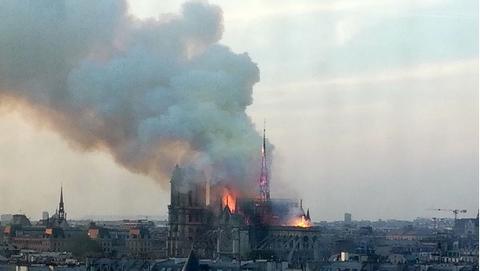
The Fire at Notre-Dame
Dany Sandron and Guillaume Legros, researchers at Sorbonne University, provide insight into the fire that devastated Notre-Dame on April 15, 2019.
“This is the darkest hour for Notre-Dame,” declares Dany Sandron, a professor of Medieval Art History and Archaeology at the André Chastel Center and head of the Mobile 3D Scanning Platform (Plemo 3D).
Nine centuries old, the “Grand Lady” had withstood the Revolution and wars. Yet nothing had so profoundly threatened the heart of its structure since its construction in the late 12th century.
According to initial investigations, the fire started in the attic of the cathedral. Fueled by wind, the flames quickly spread, consuming one of Paris’ oldest timber frames made of hundreds of oak beams. The lead roof, weighing several hundred tons, collapsed into ash. The iconic 93-meter-tall spire above the crossing of the transept fell within an hour.
“Underneath the frame, temperatures could have reached 2,000 to 2,500°C, far exceeding the melting point of lead,” explains Guillaume Legros, an associate professor at the d’Alembert Institute and former doctoral student under José Torero, a global specialist in large fires.
How Do Fires Spread?
According to Guillaume Legros, a flame can initially be weak and produce a significant amount of smoke particles, which give flames their reddish appearance. These flames radiate intensely, “preheating” nearby surfaces until they ignite.
“Contrary to common beliefs, the size of the flames has little impact on the initial fire spread scenario,” notes the scientist.
Some types of combustion, known as “smoldering combustion,” are difficult to detect because they produce no visible flames. Often occurring in porous materials like mosses, this slow combustion can ultimately lead to large-scale fires.
Clues to Determine the Fire’s Causes
Currently, all scenarios regarding the fire’s cause remain under consideration. While we must await further investigation to form solid hypotheses, certain factors may help determine the fire’s origins.
“For instance,” explains Guillaume Legros, “the initial focus of an electrical fire is very localized and extremely dark. In contrast to a fire caused by a blowtorch, which burns quickly, electrical combustion is slow, inefficient, and produces significant smoke that darkens the origin point. Conversely, in the case of an arson involving poured ethanol, the initial focus would be much larger and less distinct.”
A Necessary Structural Diagnosis
In parallel with the investigation into the fire’s origins, comprehensive analyses of the building’s structure are being conducted. While firefighters managed to save Notre-Dame, “it’s now necessary to carry out a technical diagnosis lasting several weeks to identify structural damage suffered by the cathedral,” states Dany Sandron.
Although the two bell towers remained standing, part of the vaults collapsed in three places. Moreover, the destruction of two-thirds of the roof weakened the transept facades, which are now unsupported at their summits.
“A Gothic structure like the cathedral’s holds together as a whole. It’s a skeleton. If one part is missing, it jeopardizes the entire building,” Sandron emphasizes.Gothic architecture relies on counteracting forces. As such, with the disappearance of the vaults, the flying buttresses designed to counter lateral thrusts may now push the facade walls inward.
Furthermore, the art historian highlights that “we currently can’t say whether the masonry has suffered or will suffer due to the thousands of cubic meters of water poured on Notre-Dame.” While this water was critical in extinguishing the flames, it poses a significant danger to the architecture. It saturates the stones, dissolves mortar joints, and risks loosening elements of the cathedral’s structure, threatening its stability.
This diagnosis, along with the researchers’ work, will be invaluable in guiding decisions for the future reconstruction of this Gothic masterpiece.
